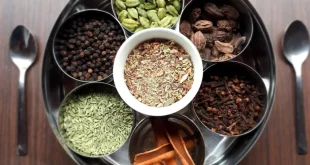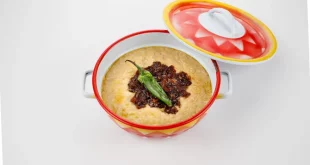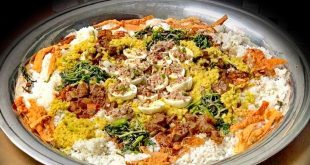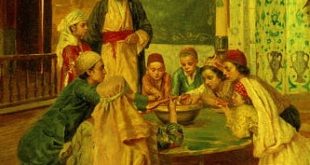The Moor community of Sri Lanka has a number of traditional beverages that have especially figured on festive occasions. Here are the main ones with a description and likely origins:
FALUDA
By far the most popular beverage among the Moors is Faluda, a refreshing drink of a rosy hue made of milk and rose syrup and often embellished with kadal-pasi or agar agar (Seaweed moss jelly) and kasa kasa (black basil seeds which assume a soft, gelatinous, translucent coating when placed in water). It may also be embellished with ispagol or psyllium (Fleawort seed) husks which is believed to have cooling and laxative properties and is especially consumed during the month of Ramadan. The rose syrup usually employed for the purpose is prepared by heating together essence of rose, sugar, water and red colouring so that it assumes a deep red colour and a consistency very much like treacle.
As for its origins, the beverage is very likely of Arabian, Persian or Indian origin, though it seems to have its origins in an ancient Persian sweetmeat. In Arabic falud or faludaj means ‘a sweetmeat of flour, water and honey’ and is said to have been introduced to the Arabs by an Arab traveller named Abdullah Ibn Jud‘an who had been at the Sassanid court before the triumph of Islam in Persia. It probably derived from the Pahlavi or Middle Persian paludag which meant ‘starch jelly’, ‘flummery’.
In Persian paluda eventually came to mean ‘a kind of sweet beverage made of water, flour and honey’ while its Arabic inspired usage faludaj which was itself of Persian origin seems to have been applied to a concoction of ground almonds, sugar and rose water. In India faluda refers to a popular drink made of rose flavoured milk and vermicelli strands though it also refers to the noodle-like vermicelli made of corn flour cooked with milk and sugar, perfumed with rose water and served cold or used as a garnish for that Indian ice cream known as kulfi which is often topped with rose-syrup. In Bombay and the regions around it faluda often refers to the drink. It is therefore possible that faluda originated either from the Persian paluda with sweetened rose flavoured milk replacing the flour and honey of the original Persian beverage or from the kulfi topped with rose-syrup so well known in India and that it took its name from the sweet vermicelli added to it, an item which probably had its origins in the Arab falud.
SARUVAT
Among other well known beverages may be included saruvat , a sherbet made with rose syrup though it may also denote a fruit juice made of the juice of citrus fruits such as lime or orange embellished with pieces of pineapple and kasa kasa. In the olden days however, saruvat is said to have been commonly made of lime, pineapple, sugar and water.
The saruvat sold commercially in Eastern towns like Kalmunai and Sammanturai are produced by mixing a syrup known as pani (formed of sugar, water and colouring, usually red or orange) with the juices of fruits like orange and pineapple and adding to it kasa kasa seeds. This is usually served cold with pieces of ice. Sometimes milk often in the form of condensed milk (tin pal) is also added to it.
As for its origins, the term saruvat is no doubt of Arab origin, being derived from the Arabic sharbat meaning simply a drink or beverage. The final t is however generally silent in spoken Arabic so that we might have to suppose that the form saruvat has arisen through the medium of Persian or Hindustani where the final t has been retained.
Although it might have ultimately had an Arab origin as suggested by the name and its occurrence in works such as the Alf Layla Wa Layla (The Thousand and One Nights) where we come across references to rose sherbet as in the tale of King Umar Al-Numan, sugared sherbet scented with rose-water as in the tale of Khalifah and sherbet flavoured with rose- water, scented with musk and cooled with snow as in the tale of Nur Al-Din Ali and his son, it were the Turks who apparently developed and popularised it.
Among the Turks, sherbet was made of the juice of lemons, water and sugar (The general history of the Turkes.Richard Knolles.1621) and also with roses, rhubarb, lemons and tamarinds (Seyahatname. Evliya Celebi. 17th century). Nevertheless simpler forms of sherbets were also known. Edward Lane in his Modern Egyptians (1837) tells us that the Egyptians have various kinds of sherbets, the most common kind being called simply shurbat or shurbat sookhar which is merely sugar and water. Nevertheless, sherbets made of the essence of roses seem to have been much favoured. For instance, we have Charles Addison in his Damascus and Palmyra. A Journey to the East (1838) referring to sherbet of roses, a pink sherbet kept in tins and sold in round cups with a lump of snow in it.
KAHUWA KOPI AND OTHER COFFEES
Another refreshing beverage, albeit a hot one, is kahuwa kopi which is made with coffee, milk, cloves, cardamoms, cinnamon and dried ginger. This beverage is also known as shukku (lit.dry ginger) in southern regions such as Galle and Colombo, especially when taken without milk. Coffee may also be consumed with milk and sugar while sometimes a mixture of raw egg, jaggery and cardamoms is added to it in which case it is known as mutta kopi or “egg coffee’. There is also ganjakopi or Ganja Coffee made by combining coffee with ganja or cannabis. It is said to be still consumed by the labouring community of the Eastern Province such as agricultural workers.
The beverage is probably of Arab origin. The term kahuwa itself seems to have originated from the Arabic qahwa ‘coffee’. Seniya Noordeen in her book on Muslim Cookery (1958) gives the term gehwa for kahuwa kopi. The tradition of adding condiments such as cardamom to coffee has very probably been influenced by Arab custom. The practice is alluded to by Edward Lane who in his Modern Egyptians says that the Egyptians often add ‘cardamon-seed’ to their coffee. In fact we find that even today, such coffee flavoured with cardamom is known in formal parlance as qahwah arabiyyah or ‘Arabic Coffee’ in the Arab world.
It is not unlikely that coffee has figured in the life of the Moors as among their Arab brethren for quite some time. Coffee was known among the Arabs since at least the 15th century. There is evidence in Arabic literature to show that the use of coffee was introduced into Aden by a certain Sheikh Shihabuddīn Dhabani who had made acquaintance with it on the African coast and who died in the Hijri year 875 (C.1470 AC).
From Yemen, it is said to have spread to Mecca, Cairo and Damascus (Hobson-Jobson. A Glossary of Anglo-Indian Words.Col.Y.Yule & A.C.Burnell.1886). Another tradition has it that coffee had its origins in the Kaffa Province south of Abyssinia before being introduced to Mokha in Yemen C.1430 by Shaykh Al- Shazili whence it began to spread to other parts of the Arab world (Love, War and Fancy. The Customs and Manners of the East from writings on the Arabian Nights by Sir Richard Burton. Ed. Kenneth Walker.1964).
Be it as it may, there can be little doubt that it were the Arabs who introduced coffee to many parts of the world beginning from about the late 15th or early 16th century. Indeed, there are those like John Ferguson (Ceylon in 1883) who believe that it was the Arab traders who first introduced to the island the coffee plant.
HERBAL, NUT AND FRUIT DRINKS
Nannari is a sherbet made with the extract of sarsaparilla (Hemidesmus indicus) and Badam made with the essence of almond and consumed with or without milk. Woodapple juice (bulanga pal) made with the pulp of the ripe woodapple fruit (Limonia acidissima), coconut milk and jaggery or sugar is also consumed. Manga pal which is similarly made save that mangoes are used instead of woodapple.
Eastern Moor folk such as those of Kalmunai also indulge in an extremely refreshing beverage made of the pulp of a melon known as velleri palam which has been mixed with sugar. This elongated yellow-skinned melon with a juicy creamy white pulp is known as puṭṭari palam among Tamils and sourced from areas like Kirankulam.
NARCOTIC DRINKS
The Moors of old are also known to have consumed an intoxicating beverage known as Sabji. This beverage is said to have been common until about the 1970s when it gradually declined. John Attygalle in his Sinhalese Materia Medica (1917) refers to sabji as being used largely by the ‘Mohammedans’. He gives it as a preparation made of ganja or cannabis powder, mixed with black pepper, cucumber, melon seeds and sugar, half a pint of milk and an equal quantity of water. The recipe however was not always the same for we were informed by several elderly folk of Gintota that the beverage was prepared with opium, cannabis, eggs, kitul jaggery, mashed banana of the kolikuttu variety and a white form of poppy seed known as vella kasakasa. Dikwella in the south is said to have been well known for the beverage.
This sabji is evidently of Indian origin and appears to be identical with the sabzi of the Indians ‘an intoxicating potion made of bhang’ (Hindustani-English Dictionary by Duncan Forbes 1857). Richard Burton in his translation of the Arabian Nights observes that sabzi is prepared with dried hemp leaves, poppy seed, cucumber seed, black pepper and cardamoms rubbed down in a mortar with a wooden pestle and made drinkable by adding milk.
Although intoxicating drinks are clearly prohibited in Islam, there are those who have sought to justify or permit the taking of narcotic substances in quantities that will not intoxicate. The Fathud-Dayyan, an Arabu-Tamil work on Islamic jurisprudence by Mappillai Alim for instance declares to be haram substances that cause injury to a person’s intelligence such as for instance toddy, arrack and other intoxicating drinks and when taken in larger quantities ganja, opium, nutmeg and its mace. It adds that a little opium or ganja may be added to medicines where necessary and that nutmeg and mace may be eaten in quantities that will not intoxicate.
Post Disclaimer | Support Us
Support Us
The sailanmuslim.com web site entirely supported by individual donors and well wishers. If you regularly visit this site and wish to show your appreciation, or if you wish to see further development of sailanmuslim.com, please donate us
 Donate
Donate
IMPORTANT : All content hosted on sailanmuslim.com is solely for non-commercial purposes and with the permission of original copyright holders. Any other use of the hosted content, such as for financial gain, requires express approval from the copyright owners.
 Sri lanka Muslims Web Portal Sri Lanka Muslims News Center
Sri lanka Muslims Web Portal Sri Lanka Muslims News Center
 Donate
Donate


